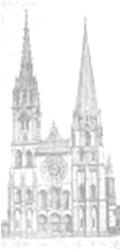
Sabbatical 2011
Tuesday, September 13
Woke up early and got to the boulangerie just after it opened; they were still putting out the pastries. Their baguette has tasted wonderful every day but after yesterday's "blah" baguette it was pure heaven.
Monsieur Yves was around the cathedral today, but inside, putting flowers on the altars and singing "Ubi Caritas". I think he qualifies as Chartres Cathedral's jester.
To the right: the apse, east wall
If I had any illusions of doing a definitive photo survey of this cathedral they are gone now. For one thing a number of things are inaccessible to photography, and others are not much use photographing until they are cleaned. I really do hope a serious photo survey is done after restoration is completed.
However it would demand real professional equipment, scaffolding, access to the cathedral after hours; and probably take a year to do it right. There is a lot here.
To the left you see a picture of one of the windows not yet cleaned. Compared with the other ones I've shown this should show you very clearly how badly the cleaning work needs to be done.
To the right and below is a picture of one of the workers up cleaning stonework this morning in the altar area. I haven't watched them cleaning windows yet but cleaning the stonework seems to be mostly a matter of careful scrubbing off 800 years of grime.
The only ones who are aware of my presence are the regular beggars, not just Monsieur Yves but several others. I do slip them a small coin each day as I go in, though the rule between us is "un foi de jour!" - 1 time a day. But mainly I stop and speak with them and ask how they are. Not many people do that. It goes a long way. They know more about Chartres cathedral than you might imagine.
And I realize I've fallen into one of the oldest, most traditional habits of pilgrimage - almsgiving.
Someone wrote yesterday that the windows were amazing considering the time they were designed and constructed. The fact is that those windows could not be designed or constructed today, at any price or effort. The secrets of making them died out 500 years ago. With all our knowledge we have never been able, since the Renaissance, to create the colors of stained glass that were developed by the medieval "vitrail" guilds of France. In particular we have never been able to come close to those deep blues. You see them in other places where glass of the same period survives in France (I saw some in Bourges) but nowhere else.
Several areas of interest today. First the three great rose windows. Actually there are a couple of dozen rose windows in the cathedral, one above every two clerestory windows. The "great" rose windows are over the west door and the north and south transepts. The west window is pure Romanesque - even though it was built as part of the Gothic cathedral. The architect decided to respect the fact that it was built over the older cathedral wall and make it match. The transept roses are pure Gothic - they absolutely flood the center of the buildind with light.
The oldest glass in the building is on the west wall, below the rose window. It dates back to 1150. The miracle is that not only the west wall but its stained glass survived the 1194 fire unharmed. The central window is the life of Mary. On the south side it is flanked by a "Redemption" window showing the Passion and Resurrection; on the north by the "Jesse tree" window showing the lineage of Jesus.
As I look at the windows in the cathedral I realize there are different minds at work here. Evidently different groups of stained glass workers were given the "contract" to design and construct specific wndows and had some freedom in the approach they took.
As you stand at the crossing of the transepts you can see all three great rose windows just by turning your head.
Lunch was another small cheap sandwich from the boulangerie and by far the tastiest yet. Fresh baked bread brushed with olive oil & basil, thin sliced jambon (ham), goat cheese, lettuce & tomato.
This evening I once again went to the Vespers service led by "Le Chemin Neuf" and stayed and talked with one of the members. "Le Chemin Neuf" (The New Road") is an ecumenical and international community of theological students studying philosophy, local priests, various committed members of the larger community, and other clergy. They invite all who would like to to join them in singing the office of vespers in the cathedral each weekday evening at 7:00 pm. They are not part of the cathedral but they are nvited to have vespers there each night. It is all sung, in French, quietly and reverently. One of the best experiences here.
Some pictures today: